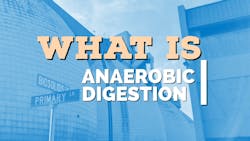Anaerobic digestion of wastewater can reduce the volume of the sludge, break down harmful pollutants, and produce biogas.
What is anaerobic digestion for wastewater treatment?
According to the EPA, anaerobic digestion is a process in which bacteria break down organic matter in the absence of oxygen. The organic matter could be animal manure, wastewater biosolids, and food wastes. Anaerobic digestion produces biogas and digestate. Digestate is the material that is left after anaerobic digestion. It is rich in nutrients. Digestate is also referred to as biosolids.
Anaerobic digestion has been used for wastewater sludge treatment. Anaerobic digestion converts organic wastes into biogas.
The US EPA developed a Co-digestion Economic Analysis (Co-EAT) model that allows the user to input the operating parameters to plant specific operations to quantify the impacts associated with anaerobic digestion. The CO-EAT model can predict the quantity of biogas produced.
What are the four stages of anaerobic digestion?
There are four stages in the anaerobic digestion process: hydrolysis, acidogenesis, acetogenesis, and methanogenesis.
In hydrolysis, bacteria break down organic compounds like carbohydrates into simple sugars. In acidogenesis, bacteria convert the simple sugars and amino acids into carbon dioxide, ammonia and organic acids. In the third stage, acetogenesis, bacteria convert organic acids into acetic acid, carbon dioxide, and hydrogen. In methanogenesis, biogas is produced by the action of methanogens.
The anaerobic digestion process is mediated by diverse types of microorganisms.
What does anaerobic digestion remove?
Anaerobic digestion transforms organic wastes into biogas while also reducing the volume of the sludge. The digestion process can improve the dewaterability of the sludge to make it easier to handle and dispose of. The biogas that is produced consists of methane and carbon dioxide.
In addition to the removal of organic wastes, anaerobic digestion can also remove harmful pollutants such as heavy metals and xenobiotics.
Is anaerobic digestion good or bad?
Anaerobic digestion is a process used at municipal and industrial water treatment facilities. It removes organic wastes, harmful pollutants, and also reduces sludge volume and produces biogas.
Steps may be implemented to improve process efficiency including screening to prevent maintenance issues by removing large materials. Simialrly, degritting can also be used to prevent accumulation of grit inside digester tanks. Additionally, digester configuration may be required for the optimal performance of the microorganisms involved in the anaerobic digestion process. This includes temperature and pH.
Fine suspended solids, ammonia, and salt may also be factors of concern in the anaerobic digestion process. The digestate from the anaerobic digestion process may contain high phosphate and may need to be treated to prevent water eutrophication, particularly in statess or localities with stringent nutrient limitations for wastewater discharge permitting.
What are the two main products of anaerobic digestion?
Biogas and digestate are the main products from anaerobic digestion.
The biogas is mostly methane, carbon dioxide, along with small amounts of other gases and water vapor. Methane is a primary component of natural gas. The trace gases include hydrogen sulfide, hydrogen, and ammonia that comprise 1% while methane comprises 60% and carbon dioxide, 30% in an anaerobic digester. Depending on the input into the digester, additional gases may be generated. These gases should be handled as per regulations.
The US EPA has a biogas toolkit for users including for the wastewater biogas sector. It also includes project phase including for operations and management. Also included is an anaerobic digester/biogas system operator guidebook that covers technical topics including for stakeholders, managers, and operators.
There are federal and state regulatory requirements for anaerobic digesters. The state regulations for wastewater anaerobic digesters can be found on the respective websites. There are also conservation practice standards for anaerobic digesters for waste management systems. The federal requirements for anaerobic digesters for industrial wastewater treatment involves reporting on methane gas emission and also includes monitoring requirements for the concentration of organic material in wastewater.
Anaerobic digestion has several benefits and also limitations. It breaks down the organic material. However for this breakdown to occur, system optimization is required. Pretreatment may be required prior to anaerobic digestion to optimize anaerobic digestion. This could be physical, thermal, or chemical pretreatment. The resulting wastewater from the digester could also require treatment prior to discharge.
About the Author
Saleha Kuzniewski
Saleha Kuzniewski, Ph.D. has authored several publications in the fields of scientific research, biotechnology, and environmental regulations. She is the winner of the 2023 Apex award for publication excellence. She is also the founder of Environmental Remediation & Innovations, LLC. Kuzniewski can be reached at [email protected].

